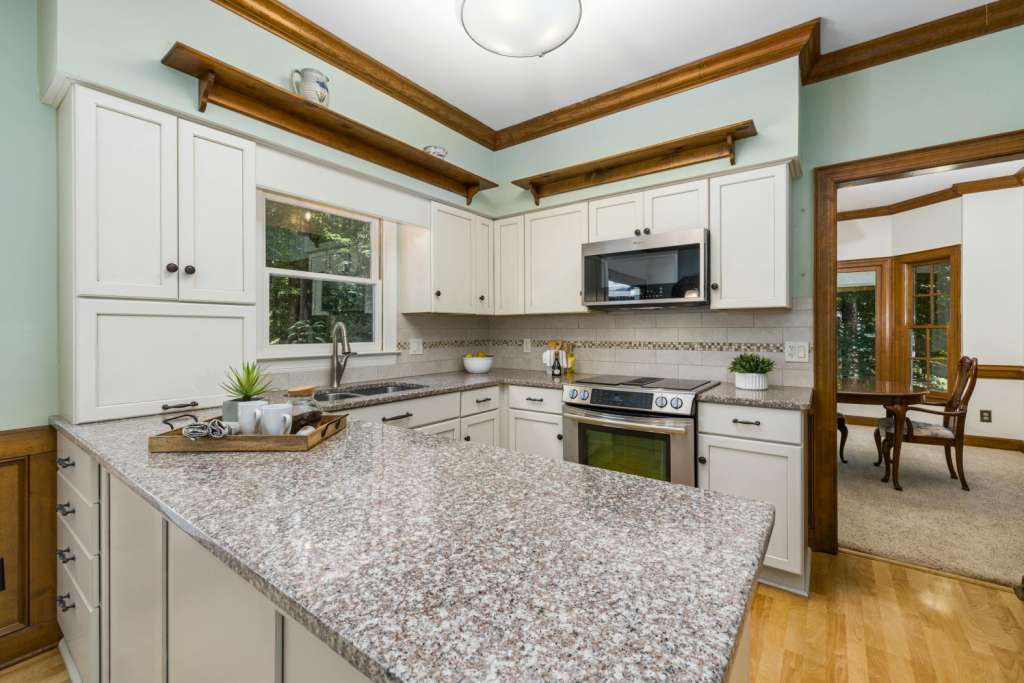Kitchen sinks come in several styles and materials, each offering distinct advantages in terms of appearance, durability, and maintenance costs.
Porcelain (commonly referred to as vitreous china) is an affordable yet classic material, boasting unassuming looks that fit seamlessly into any decor scheme. Over time, however, porcelain may discolor, and scratching may occur; its surface can also easily disintegrate over time.
Undermount
Undermount kitchen sinks attach seamlessly to countertops from beneath for an unobtrusive appearance and are easier to keep clean than traditional drop-in models, since there is no rim that traps food crumbs. Unfortunately, however, undermount sinks may be more expensive as they require custom fabrication and installation in order to be properly supported by countertops.
As with anything in a kitchen, sink material choices should be carefully considered before choosing stainless steel as a material of choice. Look for options that offer less costly alternatives that provide classic white color combinations that match most styles of kitchen design.
No matter the type of sink you choose, it is essential to balance price and functionality when making your decision. An undermount sink may cost more than traditional drop-in ones but can often provide greater functionality and aesthetics; some manufacturers even provide lifetime warranties, so you know your purchase is protected by an established brand.
Drop-in
Drop-in kitchen sinks (also referred to as top mount sinks) are one of the more traditional sink options, resting inside an opening cut into a countertop surface and sealed shut with fasteners or bolts that fasten to the rim first to form an airtight seal with this material surface.
Single-bowl kitchen sinks feature timeless beauty while remaining easy to install and use. Their elegant profile complements any kitchen aesthetic, while the deep bowls can accommodate your largest pots and pans without taking up much room in your base cabinet.
Plus, this simple installation frees up space in there for other essentials like cleaning supplies or other necessities that might otherwise occupy it! You can visit this site for tips on organizing your cleaning supplies.
Wall Mount
Wall-mounted sinks offer you greater design freedom, ideal for casual kitchens that feature rustic decor.
Wall-hung kitchen sinks come in an assortment of materials and sizes to meet your style needs. While stainless steel may be the strongest material, porcelain or enamel finishes offer timeless, classic looks.
While single basin models tend to be preferred by most consumers, dual basin models are also available for large families or households that use a lot of dish detergent.
Not only are these sinks stylish, but their versatility is another significant advantage. You can install them in multiple ways, such as above the counter for use with existing countertops or undermount for additional storage capacity.
These sinks are quick and simple to install, making them convenient and user-friendly.
Unfortunately, however, their location means they may be harder to reach for cleaning and repair purposes than traditional countertop-mounted models. You can visit this site to learn more about how to clean a porcelain sink. With more of the plumbing hidden behind walls, leaks may be hard to detect; professional services may be necessary in these instances.
Copper
Add warmth and character to your kitchen with the distinctive charm of a copper sink, featuring either its classic hammered texture or smooth finish. Copper’s natural antimicrobial properties inhibit bacteria growth for ultimate hygiene and durability; making this timeless kitchen sink choice the perfect centerpiece that enhances culinary spaces effortlessly.
Copper sinks feature an exquisite patina that will deepen over time, adding character and warmth to your kitchen while providing additional durability, making this copper sink the ideal choice for your remodeling project.
Single-basin sinks offer a larger work surface, making them an excellent option for those who regularly cook with large pots and pans. You can learn more about the features of workstation kitchen sinks by clicking the link. Furthermore, this type of kitchen sink often outshines other options because its cleaning and maintenance needs can be easily addressed by one person alone.
A farmhouse sink can add elegance to any kitchen design. These classic sinks feature an apron-front that complements virtually all cabinet styles for an added touch of sophistication in your home, as well as being easy to keep clean thanks to their naturally antimicrobial properties.
Although less costly than copper sinks, stainless steel kitchen sinks offer significant value in the long run. Their high durability means they are perfect for heavy usage, while their easy upkeep makes cleaning them a breeze with just damp cloth or sponge wipe-downs.
Solid Surface
Solid surface is a versatile thermoformed material used for countertops, sinks, and bar tops in commercial design projects. Designers also employ it for creating sculptured focal points as well as custom wall cladding—perfect for creating eye-catching focal points in their projects!
Solid surface materials are nonporous, eliminating the need for sealing. Their wide array of colors and visual textures provides endless customization opportunities, while seamless pieces can be formed together into coordinated countertops and sinks. Plus, solid surface countertops are durable, stain-resistant, and easy to maintain!
Solid surfaces are soft to the touch, making them comfortable additions to your kitchen.
Unfortunately, solid surfaces are softer than natural stone and more susceptible to scratches; additionally, high heat exposure could affect them adversely. For this reason, most manufacturers do not advise using solid surface countertops in cooking areas.
When shopping for a solid surface sink, select one that is constructed with high-quality acrylic resin to avoid its yellow aging tone and retain its white hue for longer. While more costly than other materials, solid surface sinks offer customization flexibility and can even integrate seamlessly with countertops for an impressive result.
Solid surface sinks can be mounted either adhesively or mechanically to your countertop, depending on their manufacturer’s recommendation. Furthermore, a solid surface is typically easy to repair; in case your sink becomes damaged or stained, it should often be possible to bring it back to its original condition with just some repairs and restoration measures.













